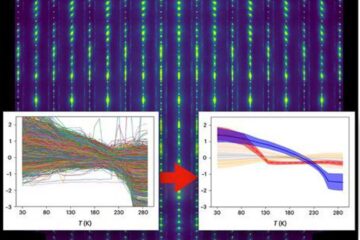Black holes — gas blowers of the Universe

A super-massive black hole acts like a lurking “monster” at the centre of the galaxy which swallows the surrounding material through the intensity of its gravitational pull.
X-ray observations indicate that a large amount of energy is produced by the in-fall of matter into a black hole, and ejected in powerful jets. Astronomers from the Max Planck Institute for Extraterrestrial Physics have now shown that these jets eject matter not only from their host galaxies but even the gas between the galaxy group members. (Astrophysical Journal, May 1st 2010)
Astronomers have long been trying to understand how black holes interact with the environment (the so-called feedback), but to date the process is poorly understood. Observations and simulations have shown that active galaxies transport huge amounts of material with their jets, which are particularly luminous at radio wavelengths, into the intra-cluster gas. Signatures of this “radio-mode feedback” are observed both in radio and in X-rays.
Recent studies have shown that the amount of gas in galaxy groups, objects consisting of several galaxies bound together such as the Milky Way and the Andromeda Galaxy, does not add up to the amount predicted by cosmology – unlike in galaxy clusters with up to thousands of individual members. Large amounts of mechanical energy injected into the gas from the central black hole may have removed part of it. However to date this was only a hypothesis. Previous group samples were limited to a handful of nearby objects populated by low luminosity radio black holes.
Using one of the largest samples of X-ray detected groups and clusters of galaxies identified by XMM-Newton together with radio observations, a team of astronomers led by Stefania Giodini at the Max Planck Institute for Extraterrestrial Physics has studied the energetics of radio galaxy feedback in galaxy groups. In the COSMOS field, where almost 300 X-ray galaxy groups have been detected, the team has been able to show that the black hole activity in the centre of galaxy groups must have a dramatic effect on the surroundings: they eject sufficient energy to blow the intergalactic gas out of the gravitational well of the galaxy group. The mystery of the missing gas in galaxy groups is solved – and the large impact of black holes in galaxy groups demonstrated for the first time.
“In galaxy groups the gas is contained by gravity. But the black holes produce so much energy that this outweighs the capacity of the group to hold its gas,” explained Stefania Giodini, the lead author of the paper. “A significant part of the gas is removed. No similar effect is observed in more massive galaxy clusters, where the huge gravitational pull restrains the gas from being removed.”
“It is impressive what a significant influence radio outflows from galaxies can have on their surroundings,” said Vernesa Smolèiæ from the California Institute of Technology, co-author of the paper. “This likely happens not only on the scales of the host galaxies of these outflows, but also on scales as large as the distance from our Milky Way to Andromeda. Radio galaxies seem to be the “trouble makers” in the Universe that can heat the gas around their host galaxies to unexpected temperatures, as well as expel a fraction of matter from galaxy groups.”
Hans Böhringer, head of the Research Group for Clusters of Galaxies and Cosmology at the Max Planck Institute for Extraterrestrial Physics, also participated to this study: “In nearby clusters we can see the short term effect of the energy outbursts occasionally in the form of radio-luminous, relativistic plasma bubbles. Direct evidence for periodic outburst behaviour can only be found by looking at their effect in a large number of groups.”
The enormous effect of individual galaxy nuclei is surprising even for astronomers. “I could never imagine to what a degree the black holes can displace the gas in galaxy groups,” says Alexis Finoguenov from the Max Planck Institute for Extraterrestrial Physics and University of Maryland, Baltimore County, “they are the glass-blowers of the Universe”.
Original work:
S. Giodini, V. Smolèiæ, A. Finoguenov, H. Boehringer, L. Bîrzan, G. Zamorani, A. Oklopèiæ, D. Pierini, G.W. Pratt, E. Schinnerer, R. Massey, A.M. Koekemoer, M. Salvato , D.B. Sanders, J. S. Kartaltepe, D. Thompson
Radio Galaxy Feedback in X-Ray Selected Groups from COSMOS: The Effect on the ICM
The Astrophysical Journal, 714, 218, May 1st 2010
Media Contact
More Information:
http://www.mpe.mpg.deAll latest news from the category: Physics and Astronomy
This area deals with the fundamental laws and building blocks of nature and how they interact, the properties and the behavior of matter, and research into space and time and their structures.
innovations-report provides in-depth reports and articles on subjects such as astrophysics, laser technologies, nuclear, quantum, particle and solid-state physics, nanotechnologies, planetary research and findings (Mars, Venus) and developments related to the Hubble Telescope.
Newest articles

Machine learning algorithm reveals long-theorized glass phase in crystal
Scientists have found evidence of an elusive, glassy phase of matter that emerges when a crystal’s perfect internal pattern is disrupted. X-ray technology and machine learning converge to shed light…

Mapping plant functional diversity from space
HKU ecologists revolutionize ecosystem monitoring with novel field-satellite integration. An international team of researchers, led by Professor Jin WU from the School of Biological Sciences at The University of Hong…

Inverters with constant full load capability
…enable an increase in the performance of electric drives. Overheating components significantly limit the performance of drivetrains in electric vehicles. Inverters in particular are subject to a high thermal load,…





















